Welcome to the best reverse osmosis systems guide for 2023!
Reverse osmosis is one of the most popular water filtration methods for removing water contaminants like chlorine, fluoride, chromium, lead, arsenic and PFAS. So, its no surprise why people have so much interest in purchasing reverse osmosis systems to purify the drinking water in their home.
The best reverse osmosis system in 2023 is the Waterdrop G3 P800, a powerful RO system that removes up to 99% of PFAS, fluoride, lead, chlorine and arsenic in water. It comes with 800 GPD flow rate and 3:1 waste water ratio, which is the highest you’ll find in a portable reverse osmosis system.
Here are the most important factors to consider in a reverse osmosis system:
- Your water source
- The contaminants in your water
- Your daily water usage/consumption
- Your mineral needs (remineralization)
Reverse Osmosis Systems Comparison Table
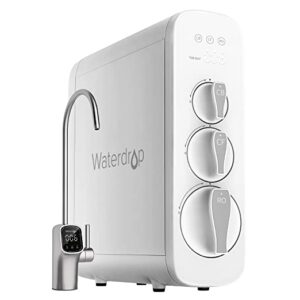
- Waste Water Ratio: 1: 3 (1 cup of water waste for 3 cups pure water)
- NSF Certification: NSF 58
- Capacity (GPD): 800 GPD
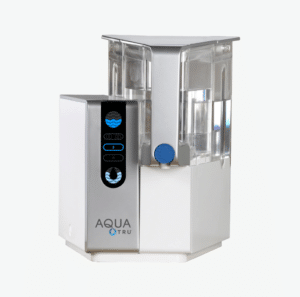
- Waste Water Ratio: 1:3 (1 cup of water waste for 3 cups pure water)
- NSF Certification: NSF 42/53/58 certification
- Capacity (GPD): 1 gallon of water within 12 to 15 minutes
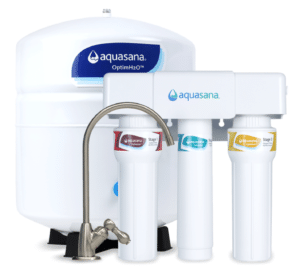
- Waste Water Ratio: 4:1 (4 parts waste water to 1 part filtered water)
- NSF Certification: NSF 42/53/58
- Capacity (GPD): 13.32 GPD
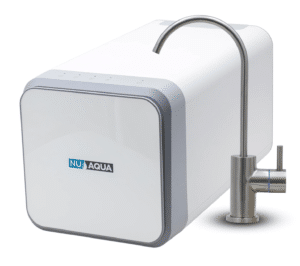
- Waste Water Ratio: 1:2
- NSF Certification: Not certified
- Capacity (GPD): 600 GPD
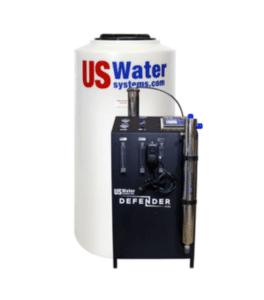
- Waste Water Ratio: 1:5
- NSF Certification: Uses NSF certified components
- Capacity (GPD): 2,000 GPD, with options for 4,000, 6,000, and 8,000 GPD models
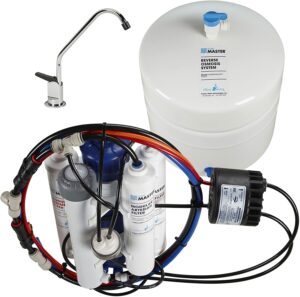
- Waste Water Ratio: 1:1
- NSF Certification: NSF 42/53
- Capacity (GPD): 50 GPD
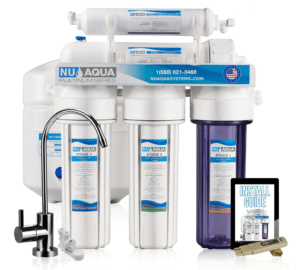
- Waste Water Ratio: 2:1
- NSF Certification: NSF-approved reservoir holding tank
- Capacity (GPD): 100 GPD
Best RO Systems:
- Best Overall RO System: WaterDrop G3 P800
- Best Countertop RO: AquaTru
- Best Under Sink RO: Aquasana Optim H20
- Good Tankless System: Nu Aqua Efficiency Series 600 GPD
- Best for Whole House: USWS Defender RO
- Best For Well Water: Home Master HydroPerfection
- Best Budget Unit: Nu Aqua Platinum Series 5
1. WaterDrop G3 P800 High Flow Rate Reverse Osmosis System
The WaterDrop G3 P800 offers advanced features and 800 GPD (gallons per day) water flow rate for mid – large houses and small workplace.
The G3 P800 is an upgrade to the previous WaterDrop model, the Waterdrop G3, which already made name for itself as one of the best systems on the market. While the G3 was only able to provide 400 GPD of water per day, the G3 P800 doubles that figure.
In addition, it comes with a faucet that has a LED screen for you to easily track the system’s process and the water quality. The G3 already had a seven-layer osmosis membrane and three carbon block filters to reduce heavy metals; the G3 P800 supplements these with a scale inhibitor to reduce water hardness. As a result, it also improves the lifespan of appliances, including itself and the faucet.
One more thing we love is the UV sterilizer with four highly efficient UV LED lamps and a 50-year lifespan. With a 99.9% success rate, these lamps ensure that no unwanted bacteria or virus find a way through your drinking water.
The installation process is straightforward and doesn’t require previous plumbing experience. It is a tankless system, so it takes little space under the sink and doesn’t allow bacterial formations around it.
Also, it’s eco-friendly enough since it’s completely BPA- and lead-free. However, the fact that it wastes one cup of unprocessed water for every three cups of pure water somewhat neutralizes its eco-friendliness.
Lastly, note that the manufacturer warns consumers not to use the G3 P800 for well water.
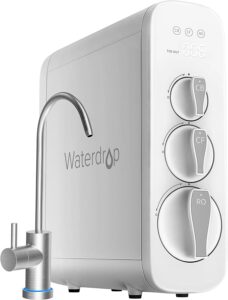
- Waste Water Ratio: 1: 3 (1 cup of water waste for 3 cups pure water)
- NSF Certification: NSF 58
- Capacity (GPD): 800 GPD
- Contaminants Removed: 94% of TDS, chlorine, chromium, cardigans, heavy metals, lead, turbidity, organic and inorganic contaminants
- Ease of Installation: Easy, under-the-counter setup
- Maintenance Requirements: Pre and post-filters every 6 months to 1 year replacement, every 2 years for membrane replacements
- Warranty: 30-day guarantee, easy warranty returns
- It comes with UV sterilization light
- It saves 12 times the water of previous models
- Easy-to-read visual monitors for TDS and filter life
- More costly than other under-the-sink models
2. AquaTru Reverse Osmosis System
AquaTRU is the best option if you’re looking for a countertop reverse osmosis system. It offers four-stage purification process, is easy to use, and it looks pretty darn nice on the countertop.
Its operating principle is as simple as it gets. Once the water reservoir is filled and the system is switched on, the AquaTru will produce a gallon of water every 15 minutes.
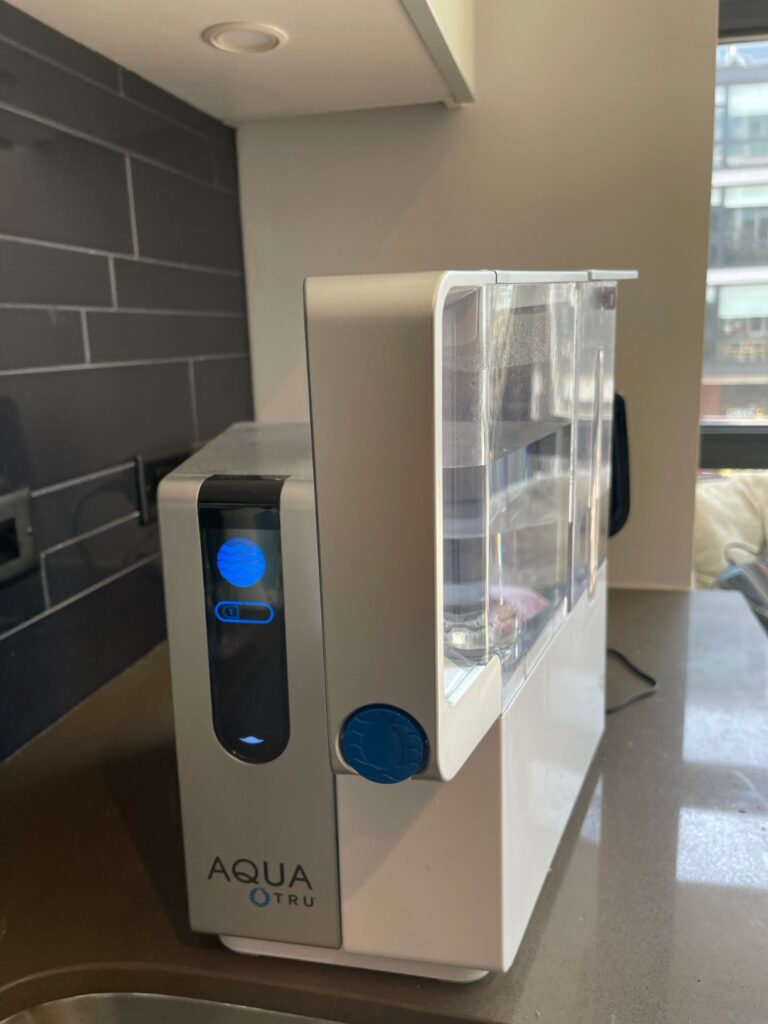
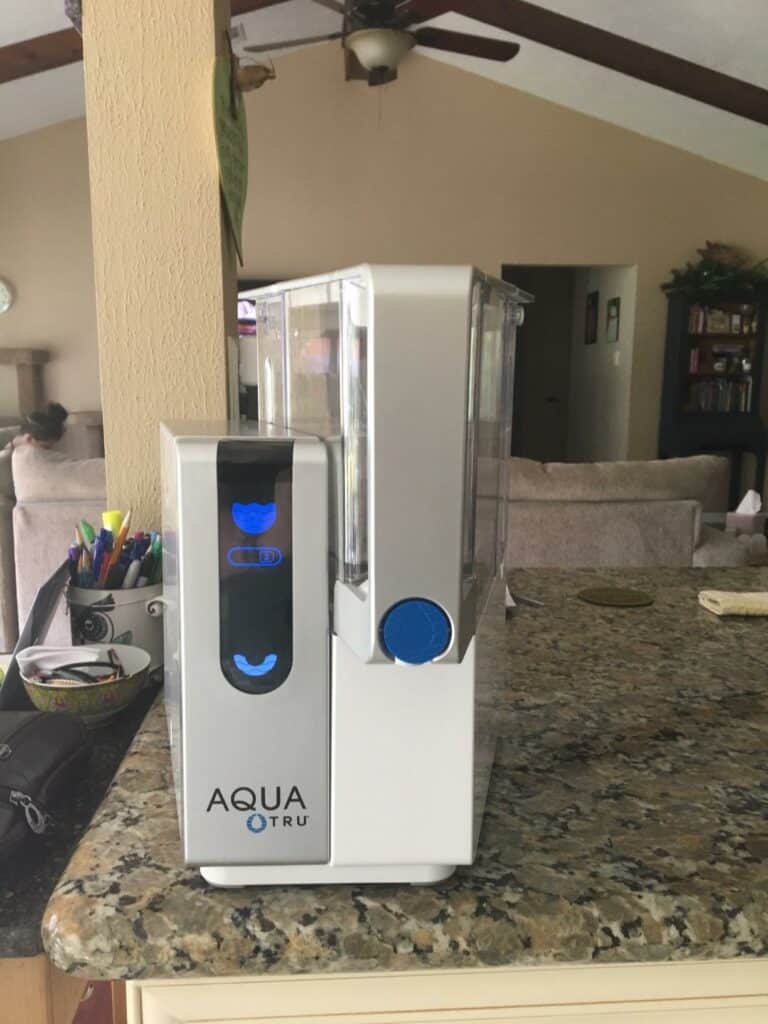
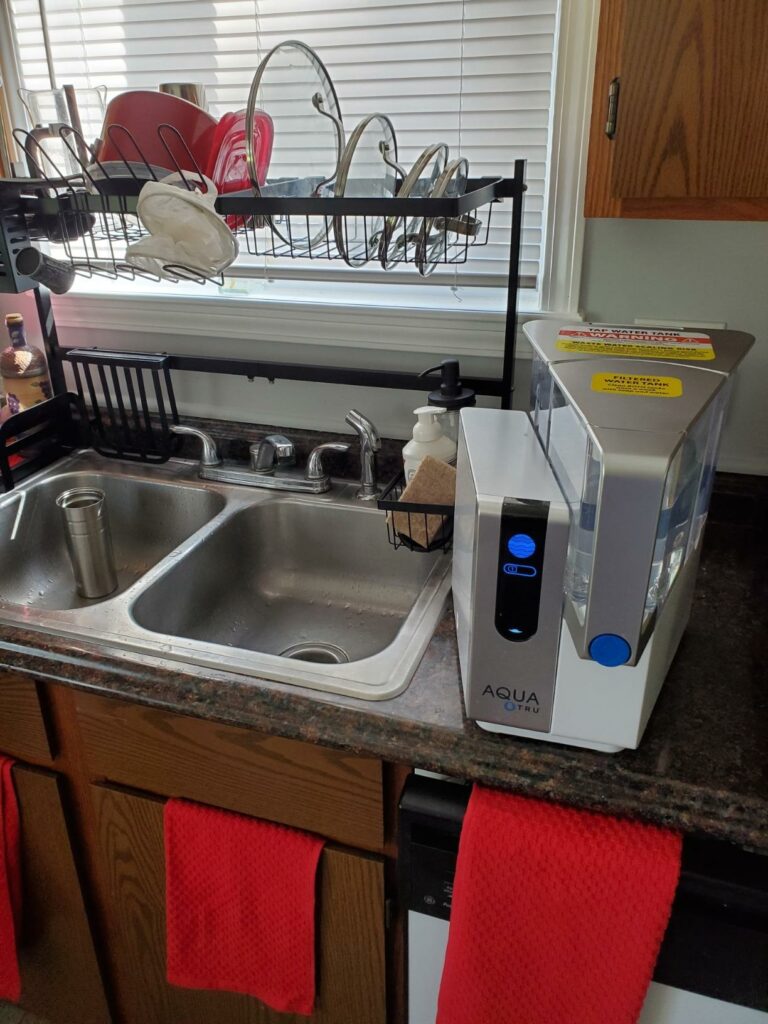
AquaTru uses a patented four-stage Ultra Reverse Osmosis Technology to filter and purify water. There’s a mechanical pre-filter that removes sediments and an activated carbon pre-filter that eliminates chlorine and chloramine. Add to that a highly effective RO filter that destroys dangerous contaminants like lead and a coconut shell VOC filter that replaces toxic chemicals with a slight taste of coconut, and you have a top-notch product.
In addition, AquaTRU removes more than 90% of the fluoride and 99% of the herbicides that come through the municipal tap systems. However, unlike the WaterDrop G3 P800 above, this unit doesn’t have a UV filter, so its levels of purification aren’t as close to under-the-sink models.
The pre-filters and the VOC filter need to be replaced after 600 gallons. The RO filter’s lifespan is double that figure: 1200 gallons. Considering that it’s a unit that’s easy to install, we consider it to be a low-maintenance filtration system.
Lastly, although it purifies enough water for small and regular households, its capacity isn’t enough to accommodate the needs of a large household or a small business.
All in all, it’s a good and reasonably priced unit to have on the countertop.

- Waste Water Ratio: 1:3 (1 cup of water waste for 3 cups pure water)
- NSF Certification: NSF 42/53/58 certification
- Capacity (GPD): 1 gallon of water within 12 to 15 minutes
- Contaminants Removed: 82 different pollutants, including chlorine, chromium, fluoride, lead, nitrates, PFAs, etc.
- Ease of Installation: No installation is necessary; it just requires an electrical outlet
- Maintenance Requirements: Pre-filter and VOC filter every 600 gallons, and the RO filter every 1200 gallons
- Warranty: 30-day guarantee and 1-year limited warranty
- Completely portable
- Compact enough to use anywhere
- More affordable than larger, complex RO systems
- You must remove any remaining water to avoid causing damage when not in use
- No UV Filter
- Not effective for large water needs
3. Aquasana Optim H20 Under Sink RO System
For homeowners looking to purchase an under-the-sink RO water filtration system with a huge tank, the Aquasana Optim H20 is the go-to product.
Its tank can hold 3.2 gallons of water, and it has a production rate of 35 GPD, which is ideal for a regular household. Its purifying capacity is also quite decent, especially considering how affordable it is.
The Aquasana Optim H20 doesn’t feature a UV filter. However, the RO membrane and carbon block filter are supported by Aquasana’s own Claryum technology. The tech entails a four-layer filtration to remove 15x more contaminants.
In turn, it’s capable of eliminating 88 harmful contaminants, including 95% of fluoride, chlorine, mercury, and arsenic, and 99% of lead and asbestos.
Those who are worried about losing healthy minerals in the filtration process can lay their concerns to rest as well since this under-the-sink system has a state-of-the-art remineralizer. In the final stage of purification, it adds healthy amounts of magnesium, potassium, and calcium back into the water.
The filters for the carbon block, Claryum, and RO need to be replaced every six months. The membrane and the remineralizer can last a year, but replacing them is quite easy since they’re all twist-off.
You can even sign up for regular filter replacements directly through Aquasana and receive discounts when you lock in your regular maintenance schedule.
Like the WaterDrop G3 P800, the Optim H20 has its own faucet that comes in three different designs: stylish chrome, brushed nickel, and bronze.
Considering how feature-packed this filtration system is, its affordability is even more appreciated. However, its efficiency rate of 18% might be a cause for concern since it means four cups of water are wasted to have one pure cup to drink. It’s honestly a lot for a product that boasts of being eco-friendly.
Additionally, calling a plumber to install it may also be a good idea since the installation process isn’t exactly straightforward.

- Waste Water Ratio: 4:1 (4 parts waste water to 1 part filtered water)
- NSF Certification: NSF 42/53/58
- Capacity (GPD): 13.32 GPD
- Contaminants Removed: Removes up to 99% of 88 different contaminants, including mercury, lead, chlorine, asbestos, and more
- Ease of Installation: Can be challenging, requires plumbing knowledge and standard tools
- Maintenance Requirements: Filter replacements every 6 months, membrane and remineralizer replacements every 12 months
- Warranty: 90-day guarantee and a 2-year warranty
- Includes a dedicated faucet
- Uses a remineralizer to reintroduce helpful minerals
- Twist off filters make replacement easy to do without disconnecting hoses
- Not for use on non-potable water sources
- Cannot integrate with existing faucets
4. Nu Aqua Efficiency Series 600 GPD Tankless System
With the exceptions of the WaterDrop G3 P800 and the AquaTru, all the RO systems we evaluated are on the bulkier side and have a lot of bells and whistles.
That’s why the Nu Aqua Efficiency is a standout among all its counterparts: it’s tankless and compact, and it looks like a cool little box that can be placed anywhere you want.
Similar to our last two entries above, The Nu Aqua Efficiency uses a four-stage filtration process. It has polypropylene and carbon block filters (PP/CB), a granular activated carbon filter (GAC), and a reverse osmosis membrane filter. Each filter takes only seconds to twist and unlock to replace, making regular maintenance easy without using any tools.
The PP and CB filters can remove volatile organic compounds, rust, sediments, and chlorine. The GAC filter takes care of hazardous chemicals and improves the taste of drinking water to a significant extent. Lastly, the RO membrane leaves no unwanted heavy metals behind.
Despite its compact look, it’s capable of providing 600 gallons of purified water every day, which is more than enough to accommodate large households and small businesses.
Moreover, the package includes a Smart Faucet that displays a blue light when the water is ready for consumption. Conversely, there’s a red one when the system needs maintenance due to low water quality.
The Nu Aqua is easy to install and requires minimum maintenance. Whereas the PP/CB filters need to be replaced once every six months, the GAC filter will last a year. The RO membrane can keep doing its job for a staggering three years before needing replacement!
The only problems we noticed are that it’s not NSF-certified and that the wastewater ratio of two cups down the drain for one cup of pure water isn’t the most efficient.

- Waste Water Ratio: 1:2
- NSF Certification: Not certified
- Capacity (GPD): 600 GPD
- Contaminants Removed: Various sediments, rust, odors, chlorine, heavy metals, fluoride, nitrates, and more
- Ease of Installation: Easy to install with five simple connectors
- Maintenance Requirements: PP/CB filter replacement every 6 months, GAC filter every 12 months, RO membrane replacement every 36 months
- Warranty: 120-day guarantee, returns require an authorization number, 5-year warranty
- Includes a Smart Faucet with Indicator
- Filter changes take only seconds to complete
- Ultra-Silent booster pump for homes with low water pressure
- Some plumbing may require additional adapters for the water lines when setting up this RO system
- Not NSF certified
5. USWS Defender RO Large Reverse Osmosis System
The USWS Defender RO is the best choice for a whole RO house system as it can produce 2,000-8,000 GPD of filtered water depending on your water production needs.
Furthermore, it comes with two atmospheric tank options—140-gallon and 250-gallon—ideal for large residences and businesses that have significant water needs.
Its centrifugal pump and motor are made of commercial-grade stainless steel, which makes it one of the most durable systems on our list. This highly durable centrifugal pump also has variable settings, which doesn’t allow the water pressure to drop no matter what.
The water purification process of the USWS Defender is quite similar to that of the WaterDrop G3 P800. The first stage consists of a 5-micron pre-filter that removes sediments, salt, and sand. It needs to be replaced once every six months.
The second stage is when RO kicks in and filters a wide variety of contaminants, including lead and arsenic. In the final stage, the whole process is supplemented by a UV disinfection system.
In addition, the USWS Defender has optional remineralization and pH neutralization features that you can control through a built-in blending valve.
USWS also offers pre-treatment options, including anti-scaling injection and bodyguard-plus to help remove chemicals and pesticides while eliminating water scale buildup. Of course, opting for pre-treatment will contribute to a bit of a hike in the price of the product.
Needless to say, its huge tank, staggering production rate, high-quality build, and amazing purification properties come at a high cost. It’s not good news that professional plumbing and electrical knowledge is also required to install it.
However, the pros outweigh the cons and we consider it to be the best option for commercial businesses.

- Waste Water Ratio: 1:5
- NSF Certification: Uses NSF certified components
- Capacity (GPD): 2,000 GPD, with options for 4,000, 6,000, and 8,000 GPD models
- Contaminants Removed: up to 99% of contaminants removed during filtration
- Ease of Installation: Not for the common household owner; requires significant plumbing and electrical knowledge; professional installation recommended
- Maintenance Requirements: the pre-filter requires replacement every 6 to 12 months,
- Warranty: 2-year warranty on components, with a lifetime warranty on the tank
- Multiple 140-gallon reservoir tanks can manifold together for a larger capacity
- Includes UV Disinfection System for eliminating airborne and waterborne bacteria
- The best warranty for a whole house system
- High-cost unit
- Difficult to take with you when you move
6. Home Master HydroPerfection Undersink Reverse Osmosis System for Well Water
There aren’t many water purification systems that are compatible with well water, but luckily, the Home Master HydroPerfection works excellently with well water.
Its nine-stage purification process and durable design are able to handle many well water contaminants. Moreover, it’s an EPA-registered product, so it can be trusted to remove unwanted elements and provide quality water.
This system has some of the best filters compared to other competitors’ models. It includes a specifically tailored sediment remover, a catalytic carbon filter, and two carbon block filters made of coconut shell.
What truly sets it apart, though, is the state-of-the-art 0.0001-micron RO membrane made of dow, the UV sterilizer, and two remineralizers. In the end, the minimal micron rating and the UV lights help remove a staggering number of contaminants from the well water. In addition, the remineralizers produce tasty and mineral-rich drinking water.
Although its production rate of 50 GPD can only provide for small households, it has a 2x faster flow rate than other comparable systems. The built-in permeate pump minimizes TDS creep and aids in increasing water production.
Despite its untidy and bulky appearance, the HydroPerfection easily fits under the sink. It’s also quite easy to install, even for a person who has no plumbing experience. It can be connected to the sink just by following the instruction manual or watching the video guide on YouTube.
Considering that it’s a well water system, the fact that its filters require replacement only once a year is surely yet another great benefit. However, its waste water rate of one cup of pure water for one cup of water down the drain is neither economical nor eco-friendly.
The five years of warranty suggests that the estimated lifespan for the product may be relatively short, so we’d recommend seeing if you can acquire an extended warranty during your purchase of the system

- Waste Water Ratio: 1:1
- NSF Certification: NSF 42/53
- Capacity (GPD): 50 GPD
- Contaminants Removed: up to 98% of contaminants, including chemicals, microplastics, chlorine, heavy metals, TDS, and more
- Ease of Installation: Includes quick-connect fittings for easy installation
- Maintenance Requirements: filters require replacement every 12 months
- Warranty: 30-day guarantee and 5-year limited warranty
- EPA-registered unit is Ideal for well water
- Includes a built-in non-electric permeate pump to reduce water waste and increase production
- Helps balance the water’s pH level without leaving it acidic
- Produces a significant amount of waste water
- Unit can take up a great deal of space under the sink
7. Nu Aqua Platinum Series 5
Not everyone has the means to go for a premium system for purifying their water. Fortunately, the Nu Aqua Platinum Series 5 is here to help.
This model is compact, easy to install and use, and will not drain your wallet in the process. That being said, the Series 5 is also a capable water purifying system that’ll provide clean and healthy drinking water.
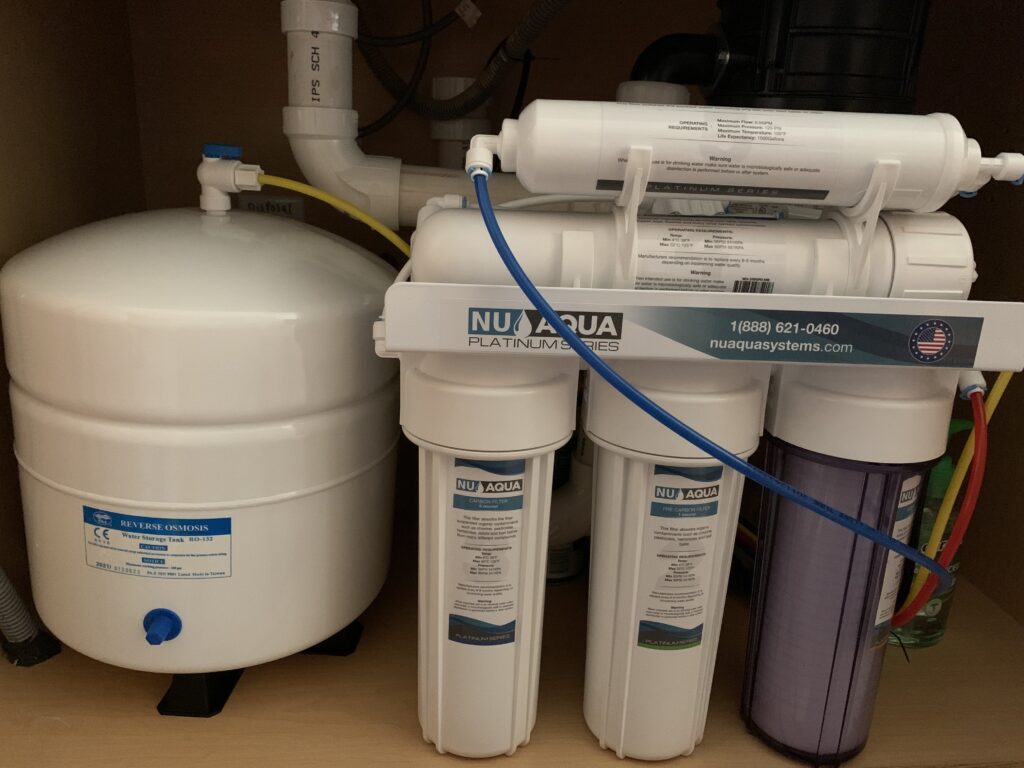
The Nu Aqua Platinum Series 5 uses a five-stage filtration process, with each stage tackling different contaminants to help prolong the life of its filters. It uses a 1-micron polypropylene filter to eliminate sediments and a HydraCoil™ Technology to remove sludge and rust.
The coconut-shell carbon block filter extinguishes heavy metals, but the device also has an RO membrane and a post-filter that gives the water a nice taste. In addition, it features a pre-installed flow restrictor and an automatic shut-off valve for optimal efficiency.
For plumbing situations that cause low water pressure, the Nu Aqua Platinum can aid in increasing it with the built-in heavy-duty booster pump. The fact that it can purify 100 gallons of water per day despite its affordability should also be lauded.
Although the filters are ridged and made of durable materials, they still need to be replaced once every 6-12 months, depending on the use. However, should you subscribe to the Nu Aqua Filter Club, they will send you new filters every six months at a discounted price.
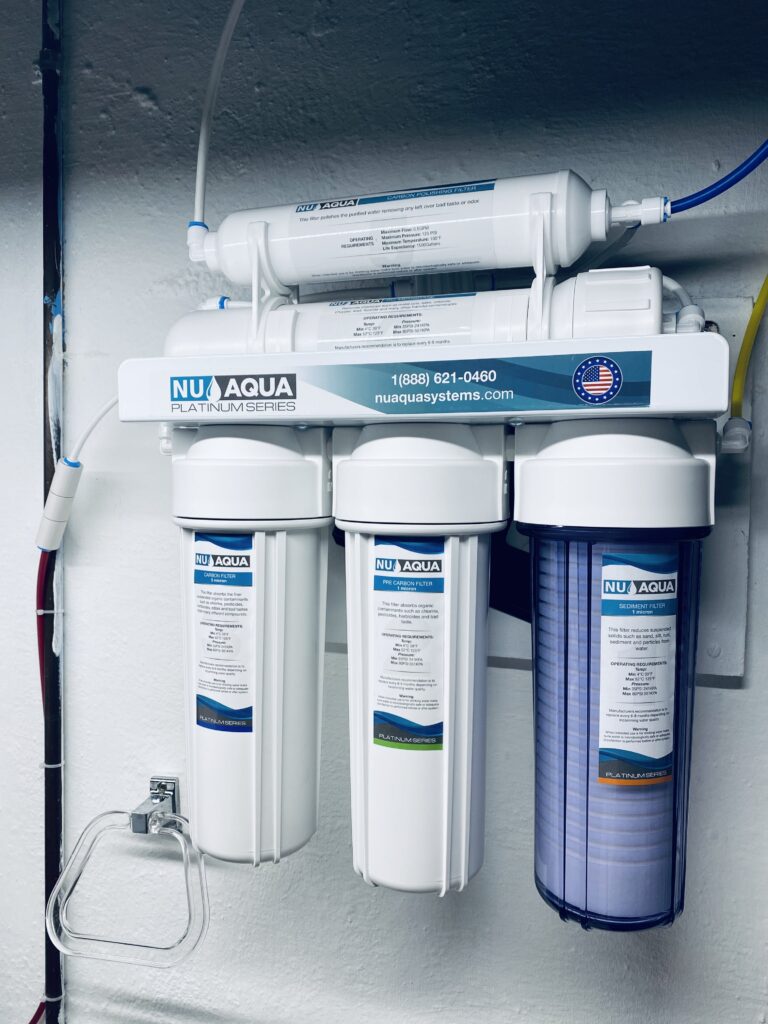
The product package also includes a leak-proof, 100% lead-free, NSF-approved chrome faucet. Additionally, they have color co-ordinated tubing to help make installation easy even for new DIYers.
All in all, even though its purification system isn’t NSF-approved, and it’s not as efficient or long-lasting as other options on our list, it makes a good budget choice for those who care about their drinking water.

- Waste Water Ratio: 2:1
- NSF Certification: NSF-approved reservoir holding tank
- Capacity (GPD): 100 GPD
- Contaminants Removed: 99% of over 1,000 different contaminants
- Ease of Installation: Easy DIY installation with included DVD and quick-connect fittings in less than one hour
- Maintenance Requirements: Filters recommended to be replaced once every 6 months
- Warranty: 120-day guarantee and 5-year warranty
- Separate chrome faucet
- Will not reduce water pressure in the home
- Includes PPM meter to measure water
- Water tubing may be too short for some under-sink setups
- May not be as durable or long-lasting as other high-end models
How We Evaluated RO Systems
To compare the several reverse osmosis water system options we had, we evaluated each system based on critical metrics such as Gallons per day (GPD) output, NSF certification and Wastewater ratio.
These are metrics buyers typically consider when on the market for a new RO system.
Here’s a breakdown of each metric:
1. We Considered GPD (Gallons Per Day) Output
The GPD measurement will vary depending on the rejection rate of the system.
For example, RO systems that have a low GPD volume will have a high removal rate, and vice versa. High GPD amounts indicate a lower removal rate, as water moves more freely through the membrane.
Naturally, the size of each system will also have a bearing on the output – when the reservoir tank is large, the GPD will also reflect a larger volume.
Here are the top performing GPD reverse osmosis systems:
| RO System (Best to Worst) | GPD Output |
|---|---|
| USWS Defender RO | 2,000 |
| Waterdrop G3 P800 | 800 |
| New Aqua Efficiency Series 600 GPD | 600 |
| Nu Aqua Platinum Series 5 | 100 |
| Home Master HydroPerfection | 50 |
| Aquasana Optim H20 | 13.32 |
| AquaTRU | 1 gallon per 15 minutes |
2. We Considered NSF Certification (National Sanitation Foundation) Ratings
A certification by the National Sanitation Foundation verifies how effective RO water filtration systems are at removing contaminants, as claimed by each manufacturer. It also means that the manufacturer used FDA-approved materials.
There are many NSF certification standards, but the two—NSF 42 and NSF 53—are most commonly used for water filtration. RO systems will either carry an NSF 42 (for reduction of non-health-related contaminants) or an NSF 53 (for reduction of health-related contaminants) certification or both.
Of course, not all brands adhere to NSF standards or carry a certification. You can compare these top seven RO models and how they stand up to regulations in the table below.
| RO System (Best to Worst) | NSF Certification |
|---|---|
| Waterdrop G3 P800 | NSF 58 |
| AquaTRU | NSF 42/53/58 |
| Aquasana Optim H20 | NSF 42/53/58 |
| Home Master HydroPerfection | NSF 42/53 |
| USWS Defender RO | Uses NSF certified components |
| Nu Aqua Platinum Series 5 | NSF-approved reservoir holding tank |
| New Aqua Efficiency Series 600 GPD | Not certified |
3. Wastewater Ratio Was Considered In Our Testing
The wastewater ratio is a critical aspect of an ro system. In the past, typical systems had ratios of 4:1, where the RO system wasted approximately 75% of the water while creating purified water.
However, advancement in technology have allowed manufacturers to offer lower waste ratios and even create Zero-Waste RO systems. These alternatives are more eco-friendly.
After thoroughly analyzing these top seven RO units on our list, here are their wastewater ratios:
| RO System (Best to Worst) | RO System (Best to Worst) |
|---|---|
| USWS Defender RO | 1:5 |
| Waterdrop G3 P800 | 1:3 |
| AquaTRU | 1:3 |
| New Aqua Efficiency Series 600 GPD | 1:2 |
| Home Master HydroPerfection | 1:1 |
| Nu Aqua Platinum Series 5 | 2:1 |
| Aquasana OptimH2O | 4:1 |
4. System Components Were Considered
A proper and effective RO water filter system will use at least four essential components such as:
- A sediment filter, which removes sediments like silt and sand.
- A pre-carbon block, which removes heavy metals.
- An RO membrane removes a variety of contaminants and is the most crucial part of these systems.
- A post-carbon filter, which is the last line of defense and might sometimes give the water a better taste.
There are two common types of membranes that a RO system will use. They include either a thin film composite (TFC) or a cellulose acetate (CA) membrane. The TFC membranes are more efficient and have a far superior performance than the CA types. However, the CA reverse osmosis membrane is more resistant to chlorine.
Some manufacturers will include more filtration stages for higher purity; a good example is UV sterilizers. Others, though, re-introduce beneficial minerals back into the water supply, like remineralizers and pH neutralizers.
5. TDS (Total Dissolved Solids) Rating Was Considered in Our Review
One term you may find when exploring reverse osmosis water filters is TDS rating. TDS stands for total dissolved solids, and a standard range falls between 50 ppm (parts per million) and 1,000 ppm for safe drinking water.
The dissolved solids can be organic or inorganic materials, ranging from molecular or micro-granular sizes. Organic materials include algae, bacteria, or pesticides, while inorganic materials can be lead, calcium, chlorine, etc.
Each RO water filter system will provide various TDS readings, depending on the unit’s functionality. Having a TDS monitor or a way to measure the TDS levels is beneficial when using a reverse osmosis system.
Frequently Asked Questions
More often than not, brands will include their removal rates in product descriptions. Whether these numbers are trustworthy or not depends on the certifications of their systems.
For example, the Home Master HydroPerfection has two NSF certificates as well as an EPA registration. So, the numbers it boasts are reliable, and it has the best removal ratio of all.
Similarly, our recommended system, the WaterDrop G3 P800, has an NSF-58 certificate, and its removal rate is also something to behold.
The average price of a reverse osmosis system for a small house is $200-2,000. On the other hand, units that are more suitable for large houses and businesses can reach up to $8,000.
Reverse osmosis systems are typically installed in the kitchen, under the sink. However, if you have a whole-house unit, it can go in a utility room or garage as it’s significantly larger.
The size of a whole house RO system varies, but it provides for five or more bathrooms with a 550-gallon tank.
The style and type of the system you choose will determine what you require for installation. Many under-the-sink models will require a screwdriver, drill and drill bits, pencil, tape measure, bucket, masking tape, safety glasses, utility knife, and an adjustable wrench.
Big units, on the other hand, might require professional plumbing and electrical knowledge.
The average lifespan of an RO water system is 10 to 15 years with proper periodic maintenance and care.
WaterDrop, whose G3 P800 model sits at the top of our list, is the best reverse osmosis brand out there. However, USWS produces the best systems for large houses and commercial use. In addition, brands like APEC and iSpring are also popular.
Not always. Manufacturers tend to warn their customers not to purify well water with a system that’s not specifically made for it.
The Home Master HydroPerfection is a good well water RO system.
Conclusion
In conclusion, WaterDrop G3 P800 is the top RO system from our evaluation. It is highly effective and wastes very little water. However, it’s not compatible with well water. If you want to purify well water, then look no further than the Home Master Hydro Perfection system.
If you’re looking for an RO system to use commercially, the USWS Defender is the best option, thanks to its huge capacity and high flow rate. For a good countertop system, we recommend AquaTru.